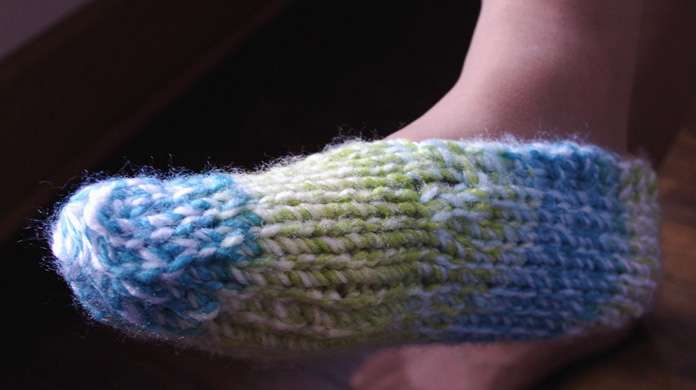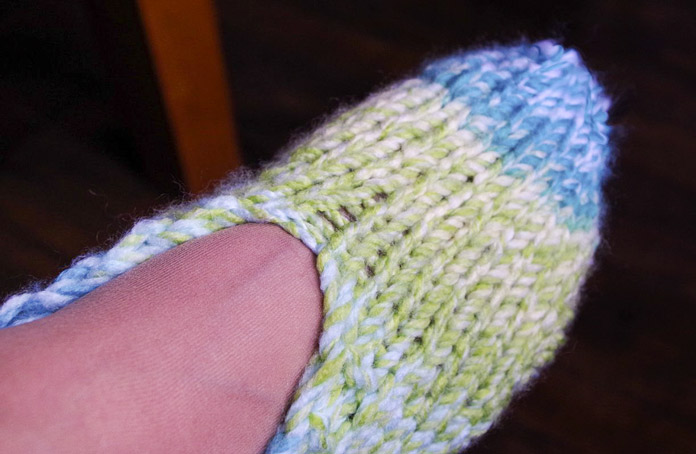While looking for free patterns for children’s items that could be knit with Toy Box yarn for yesterday’s post, I discovered an absence of patterns for one project category, namely slippers. So I decided to try knitting some with this bulky, but light and airy self-striping yarn.

These cozy slippers are a really quick knit, perfect for last minute gifts.
These quick-to-knit slippers start at the heel with a provisional cast-on. When the knitting is finished, the provisional cast-on is removed and the sides are grafted together.

The neatly grafted heel seam is invisible and give the heel a comfortable, sleek finish.
The body of the foot has a garter stitch edging on it and is worked flat in rows, with some heel shaping.

Each row begins with a purlwise slipped stitch, which gives the edge a braided look. The garter stitch edging gives it some structure.

These comfortable, warm and soft slippers can be made in less than a day. You can see the halo around the stitches.
To make these slippers, you’ll need 1 ball of Toy Box, and size 7mm needles (choose circular for magic loop or dpns, as the toes are worked in the round.
Gauge is not essential for this pattern.
Instructions are given for a child’s small. Instructions for (child’s large, adult small, and adult large are in parentheses).
The pattern
Cast on 15 (19, 19, 21) sts with scrap yarn for a provisional cast-on.
Row 1: With Toy Box, sl first st pwise, k5 (7, 7, 9), k1tbl, m1, k1, m1, k1tbl, knit rem sts—17 (21, 21, 23) sts.
Row 2: Sl first st pwise, k2, p3 (5, 5, 6), p1tbl, p3, p1tbl, p3 (5, 5, 6), k3.
Row 3: Sl first st pwise, k5 (7, 7, 9), k1tbl, m1, k3, m1, k1tbl, knit rem sts—19 (23, 23, 25) sts.
Row 4: Sl first st pwise, k2, p3 (5, 5, 6), p1tbl, p5, p1tbl, p3 (5, 5, 6), k3.
Row 5: Sl first st pwise, k5, (7, 7, 9), k1tbl, m1, k5, m1, k1tbl, knit rem sts—21 (25, 25, 27) sts.
Row 6: Sl first st pwise, k2, p3 (5, 5, 6), p1tbl, p7, p1tbl, p3, (5, 5, 6), k3.

With a simple twist of a stitch and a column of purl stitches, the sole of the slipper takes shape.
Small Size only
Row 7: Sl first st pwise, k2, k1tbl, k7, k1tbl, knit rem sts
3 larger sizes only
Row 7: Sl first st pwise, k (7, 7, 9), k1tbl, m1, k7, m1, k1tbl, knit rem sts—(27, 27, 29) sts.
All sizes
Row 8: Sl first st pwise, k2, p3 (5, 5, 6), p1tbl, k1, p5 (7, 7, 7), k1, p1tbl, p3 (5, 5, 6), k3.
Row 9: Sl first st pwise, k5 (7, 7, 9), k1tbl, p1, k5 (7, 7, 7), p1, k1tbl, knit rem sts.
Rows 10-15 (17, 17, 19): Rep rows 8 & 9. If your foot is longer, you can add more repeats here.
Next Row: Rep row 8.
Next Row: Sl first st pwise, k3 (5, 5, 7), ssk, k1tbl, p1, k1, k2tog, k2 (4, 4, 4), p1, k1tbl, k2tog, knit rem sts—18 (24, 24, 26) sts.
Next Row: Sl first st pwise, k2, p (2, 4, 4, 5), p1tbl, k1, p4 (6, 6, 6), k1, p1tbl, p2 (4, 4, 5), k3.
Last Row: K4 (6, 6, 8), k1tbl, p1, k4 (6, 6, 6), p1, k1tbl, knit rem sts.

To make the toe, start knitting in the round and once the ideal length is reached, you start decreasing until a small number of stitches remain to be grafted.
There’s a little bit of shaping just after the join to knit in the round so that the front part of the foot isn’t saggy and the slipper hugs the ball of the foot and the toes.
Join to continue working in rounds.
Rnd 1: K3, ssk, knit to last 5 sts, k2tog, k3—16 (22, 22, 24) sts.
Rnd 2: K4 (6, 6, 8), k1tbl, p1, k4 (6, 6, 6), p1, k1tbl, knit rem sts.
Rep Rnd 2 until work measures 5 (6.5, 7, 7.5)”.
Toe
Rnd 3: *K3 (3, 3, 4), k2tog; rep from * 2 (3, 3, 3, 3) more times, knit rem st(s)—13 (18, 18, 20) sts.
Rnd 4: Knit.
Rnd 5: *K2 (4, 4, 3), k2tog; rep from * 2 (2, 2, 3) more times, knit any rem sts—10, (15, 15, 16) sts.
Rnd 6: Knit.
Smallest Size only: Go to Finishing section
3 larger sizes
Rnd 7: *K (3, 3, 2), k2tog; rep from * (2, 2, 3) more times, knit any rem sts—(12) sts.
Rnd 8: Knit.
Finishing
Knit 3, then divide Toe sts in half on two needles and graft together with Kitchener stitch. Weave in end.
Heel: Unravel provisional cast on and divide sts in half on two needles. Graft together with Kitchener stitch. Weave in all ends.

The heel and the edging give these slippers a nice fit and their unique style.
I hope you’ve enjoyed knitting these slippers. Tomorrow we’ll look at one more project to knit for little ones out of Toy Box.
This is part 4 of 5 in this series.
Go back to part 3: 6 patterns are very soft knit up in Toy Box yarn
[shareaholic app=”follow_buttons” id=”23784471″]
